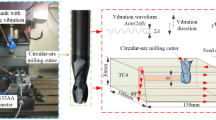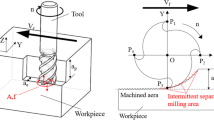Abstract
Ti6Al4V is usually considered difficult to machine, and therefore, it causes severe tool wear and shortens tool life while being machined during conventional milling, leading to loss of quality and accuracy of the machined parts. In this paper, the experiment of ultrasonic-assisted milling of Ti6Al4V was conducted to study the tool wear mechanism in ultrasonic-assisted milling process and investigate the influence of the wear variable state of tool continuous cutting on the cutting process in ultrasonic-assisted milling and conventional milling. The experimental analysis showed that oxidation wear, adhesive wear, and diffusion wear occurred in ultrasonic-assisted milling; however, longer tool life was achieved when machining under the same conditions as compared to that of conventional milling. On the other hand, the curl angle of chip generated from ultrasonic-assisted milling was smaller than that from conventional milling in the same wear time. In addition, the burr produced by ultrasonic-assisted milling was not obvious, and under the coupling effect of ultrasonic-assisted milling, lower cutting force, improved surface roughness, and lower cutting temperature were obtained as compared to those of conventional milling under the same wear time.














Similar content being viewed by others
References
Guang CHEN, Zhihong KE, Chengzu REN, Jun LI (2016) Constitutive modeling for Ti-6Al-4V alloy machining based on the SHPB tests and simulation [J]. Chin J Mech Eng 29:962–970
Ulutan D, Ozel T (2011) Machining induced surface integrity in titanium and nickel alloys: a review. Int J Mach Tool Manu 51:250–280
Mhamdi MB, Boujelbene M, Bayraktar E (2012) Surface integrity of titanium alloy Ti-6Al-4V in ball end milling. International Conference on Solid State Devices and Materials Science Physics Procedia 2012(25):355–362
Su HH, Liu P, Fu YC (2012) Tool life and surface integrity in high-speed milling of titanium alloy TA15 with PCD/PCBN tools [J]. Chin J Aeronaut 25:784–790
Ezugwu EO, Bonneya J, Silvab RBD (2007) Surface integrity of finished turned Ti-6Al-4V alloy with PCD tools using conventional and high pressure coolant supplies. J Mach Tools Manu 47:884–891
Zhao B, Li PT, Zhang CY et al (2019) Effect of ultrasonic vibration direction on milling characteristics of TC4 titanium alloy [J]. Acta Aero-nautica et Astronautica Sinica:40
Liu J L, Zhang B, Bai Q, et al. Temperature prediction of tool/workpiece contact zone in titanium milling [J]. Acta Aero-nautica et Astronautica Sinica, 2018,39(12): (in Chinese).
Guo J, Jianguo Z, Pan Y, Renke K et al (2019) A critical review on the chemical wear and wear suppression of diamond tools in diamond cutting of ferrous metals. Int J Extrem Manuf:01
Dong G, Wang X, Gao S (2018) Molecular dynamics simulation and experiment research of cutting-tool wear mechanism for cutting aluminum alloy. Int J Adv Manuf Technol 96(1-4):1123–1137
Rehman GU, Jaffery SHI, Khan M, Ali L, Khan A, Ikramullah Butt S (2018) Analysis of burr formation in low speed micro-milling of titanium alloy (Ti-6Al-4V). Mech Sci 9(2):231–243
Ambati R, Huang Y (2011) FEM mesh-dependence in cutting process simulations. Int J Adv Manuf Technol 53:313–323
Yong-hong FU, Kai-long XIAO, Xi-jun HUA et al (2013) Cutting trial and performance analysis of surface micro-grooves turning tools [J]. China Surf Eng 26(6):106–111.45 (4) : 529-535
Xie J, Luo MJ, Wu KK et al (2013) Experimental study on cutting temperature and cutting force in dry turning of titanium alloy using anon-coated micro-grooved tool [J]. Int J MachTools Manu 73:25–26
Wang Q, Liu Z (2016) Evolutions of grain size and micro-hardness during chip formation and machined surface generation for Ti-6Al-4V in high-speed machining. Int J Adv Manuf Technol 82:1725–1736
Ding R, Guo ZX (2004) Miscrostructural evolution of a Ti-6Al-4Valloy during β-phase processing: experimental and simulative investigations. Mater Sci Eng A 365:172–179
Rotella G, Umbrello D (2014) Finite element modeling of microstructural changes in dry and cryogenic cutting of Ti6Al4V alloy. CIRP Ann Manuf Technol 63:1–4
Qiang LIU, Huan LIU, Songmei YUAN (2016) High accurate interpolation of NURBS tool path for CNC machine tools [J]. Chin J Mech Eng 29:911–920
Chen T, Song L, Li S, Liu X (2019) Experimental study on wear characteristics of PCBN tool with variable chamfered edge [J]. Chin J Mech Eng:32–37
Weinert K, Biermann D, Bergmann S (2007) Machining of high strength light weight alloys for engine applications [J]. Annals of the CIRP 56(1):105–108
Ming C, Ya-dong G, Ning Y et al (2017) Experimental study on surface quality of single crystal DD98 in micro-milling processes [J]. China Mech Eng 28(11):1261–1265
Chen G, Ren CZ, Yang XY, Jin XM, Guo T (2011) Finite element simulation of high-speed machining of titanium alloy (Ti-6Al-4V) based on ductile failure model. Int J Adv Manuf Technol 56:1027–1038
Shi Q, He N, Li L (2012) Analysis on surface integrity during high speed milling for new damage tolerant titanium alloy. Transaction of Nanjing University of Aeronautics and Astronautics 29(3):222–226
Ming L, Jing W, Baohai W, Dinghua Z (2017) Effects of cutting parameters on tool insert wear in end milling of titanium alloy Ti6Al4V [J]. Chin J Mech Eng 30:53–59
Khan MA, Jaffery SHI (2019) Statistical analysis of energy consumption, tool wear and surface roughness in machining of titanium alloy (Ti-6Al-4V) under dry, wet and cryogenic conditions[J]. Mech Sci 10:561–573
Li GC, Sun J, Li JF, Song LY, Li WD (2014) Accurate 3D modeling and software implementation of end mill [J]. J Comput Aided Des Comput Graph 3(26):(in Chinese)
Acknowledgments
The authors sincerely thank Professor Hua-dong Yu of Changchun University of Science and Technology for his critical discussion and reading during manuscript preparation.
Funding
This work was supported by “Supported by national basic scientific research program” (JCKY2017208B006).
Author information
Authors and Affiliations
Corresponding author
Additional information
Publisher’s note
Springer Nature remains neutral with regard to jurisdictional claims in published maps and institutional affiliations.
Rights and permissions
About this article
Cite this article
Liu, Q., Xu, J. & Yu, H. Experimental study of tool wear and its effects on cutting process of ultrasonic-assisted milling of Ti6Al4V. Int J Adv Manuf Technol 108, 2917–2928 (2020). https://doi.org/10.1007/s00170-020-05593-3
Received:
Accepted:
Published:
Issue Date:
DOI: https://doi.org/10.1007/s00170-020-05593-3




